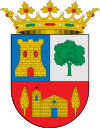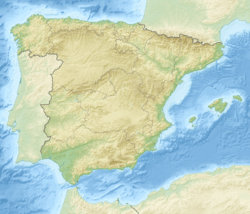Oliete facts for kids
Quick facts for kids
Oliete
|
|||
|---|---|---|---|
 |
|||
|
|||
| Country | Spain | ||
| Autonomous community | Aragon | ||
| Province | Teruel | ||
| Municipality | Oliete | ||
| Area | |||
| • Total | 85 km2 (33 sq mi) | ||
| Population
(2018)
|
|||
| • Total | 364 | ||
| • Density | 4.282/km2 (11.09/sq mi) | ||
| Time zone | UTC+1 (CET) | ||
| • Summer (DST) | UTC+2 (CEST) | ||
Oliete is a small town in the province of Teruel, which is part of the Aragon region in Spain. In 2017, about 357 people lived there. It's a place with a lot of history and natural beauty.
Contents
Exploring Oliete's History and Nature
Oliete has many interesting places to visit. You can find historical buildings right in the village. There are also amazing natural spots and ancient sites nearby.
Historical Buildings in Oliete
- The Church of Ntra. Sra. De la Asunción: This church was built in the 18th century. It has a special bell tower made in the Mudejar style.
- Donjuana House: This grand house from the 17th century is a beautiful example of Renaissance architecture. It stands proudly on the church square.
- Hermitage of San Bartolomé: This is the only chapel found inside the town itself. It honors San Bartolomé, who is the town's patron saint.
- Ancient Arches: Oliete has three old arches that date back to the Middle Ages. They were once fortified entrances to the town.
- The Arch of the Holy Martyrs: You can find this arch at the start of Mayor street.
- The Arch of Santa Barbara: This arch is located at the end of the street with the same name.
- The Arch of Pilar: This one is at the end of Baja street.
Natural Wonders and Ancient Sites
Oliete's surrounding area is full of natural beauty and historical treasures.
Oliete's Reservoirs
These large water bodies are important for the region.
- Cueva Foradada Swamp: This reservoir collects water from the Martín River. Its dam was built between 1903 and 1927. It can hold a huge amount of water, about 22 million cubic meters! You might see vultures, eagles, and mountain goats near its banks.
- Congosto Swamp: This reservoir gathers water from the Escuriza River. It was built in the late 1800s.
Peaceful Hermitages
These small chapels are often found in quiet, beautiful locations.
- Hermitage of the Virgin of the Cantal: This shrine was built around 1660. It honors a statue of the Virgin Mary that was found hidden under a "cantal" (an Aragonese word for rock).
- Calvary Hermitage: This chapel has a single nave (main part of the church). It was built in 1680.
- Hermitage of San Pedro de los Griegos.
Prehistoric Art and Sanctuaries
Oliete is home to very old human history.
- El Frontón de la Tía Chula (Paintings): This site has small, simple paintings from the Copper Age and Middle Bronze Age (around 2500-1600 BC). What's really cool is a hole in the rock where these paintings are. Sunlight passes through it during the spring and fall equinoxes. This makes it the world's oldest sun sanctuary, about 4500 years old!
Ancient Iberian Villages
Discover how people lived thousands of years ago.
- El Palomar: This ancient settlement was built around the 3rd century BC. It shows us how Iberian people lived in this area. It was destroyed during the Sertorian Wars around 79-72 BC.
- El Cabezo de San Pedro de los Griegos: This site is famous for its two original towers. They are thought to be the oldest towers in Aragon.
Oliete's Natural Landscapes
The area around Oliete offers unique natural features.
- Sima de San Pedro de los Griegos: This is a huge cave, or "chasm," about 100 meters wide and 108 meters deep. It's special in Europe because of its size and the many different living things found at the bottom. There's even a lake about 25 meters deep inside!
- The Orchard (Huerta): Years ago, Oliete's orchard was very large and productive. Today, it's not as active, partly because many people moved away from rural areas in the last century.
- The Olive Grove (Olivar): Oliete has many olive trees, especially the 'Empeltre' variety. The town's name, Oliete, actually comes from the Latin word Olivetum, which means "olive grove." Sadly, about 70% of the olive groves are not being used today. Oliete is part of the "Oil Aragon" special designation for olive oil. A project called Apadrinaunolivo.org is working to save the 100,000 abandoned olive trees.
- The Poplar Grove (Chopera): This area of poplar trees was planted in the mid-20th century. It covers about a quarter of the town's garden area.
See also
 In Spanish: Oliete para niños
In Spanish: Oliete para niños

All content from Kiddle encyclopedia articles (including the article images and facts) can be freely used under Attribution-ShareAlike license, unless stated otherwise. Cite this article:
Oliete Facts for Kids. Kiddle Encyclopedia.



